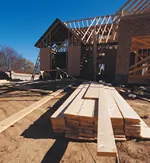Site selection can be a critical decision in the long-term enjoyment of your home. Many pitfalls await you, and not knowing about them can turn building your dream home, and living in it, into a nightmare.
Most future homeowners have a very clear idea of the size and style of home they intend to build, but choosing the proper site can be a little more tricky.

Knowing the major criteria for a suitable home site, and checking each one of them thoroughly, can make your new home a constant joy once these factors have been carefully researched. Below are some important factors to take into consideration regarding site selection.
Affordability
Although there are exceptions, it is generally recommended that you spend no more than 20% of the total cost of the house and land on a building site. For example, if you have $120,000 to invest in a home, you should spend no more than about $24,000 for the land.
Local Area
Choosing a site which is convenient to work, schools, shopping, churches, hospitals, etc. is always a popular choice because of the convenience. This type of area may look great, but just to be sure, ask some questions. For example, if the area is incorporated, what is the total annual property tax in that municipality? The tax rate is not what matters, because one town may charge the rate on 100% of the fair market value of your property, and another town may charge the rate on only 60% of the fair market value. Get the total tax, not the rate. Then decide whether you can and want to pay that amount each year in property taxes.
What municipal services are provided, such as police and fire protection, water, sewer, etc.? The quaint little town of Sunset View may be a pastoral delight, but that won’t help much when you have a fire, need the police, or have to bring in your own water and sewage systems.
How good is the local school system? One way to find this out in advance is by noting the size and quality of the local library. This is usually a good indication of how much emphasis is placed on education in the area.
Neighborhood
Spend some time in your neighborhood-to-be, especially when most people are coming and going. Is this neighborhood too big or too small for your taste? Are its streets heavily traveled or fairly desolate?
Zoning
Go to the local planning
office and ask to see the map designating residential, commercial and industrial areas, and check out residential density. Don’t risk building if it’s possible that an industrial plant or a fast-food restaurant may become your neighbor. Make sure that the property around you will not be far more crowded and less valuable than your own.
Site Accessibility
Will your home site be easily accessible in severe weather? Is the road or street alongside your property adequate? If you want to live high on a hill, or deep in a valley, you will need about 10 feet of driveway for every foot above or below street level.
Improved & Unimproved Ground
Ground Improved lots are those located where the roads and utilities are already in, and the site is ready to be built on; naturally, these lots cost more. Before you buy an improved lot, check at the local municipal offices to see if there are any restrictions regarding the kind or size of house you can build.
Unimproved ground must be improved at your expense. This means far more than clearing your land and preparing it for building. You will have to pay all or some of the cost to bring in utilities, streets, sidewalks, fire hydrants, street lights, and so on. Again, check the local planning office and find out exactly what you are getting into.
Soil Conditions
There’s no way you can tell what the soil is like just beneath the surface, so hire a civil engineer to do that job for you. If he suspects trouble, he may recommend soil testing. This may cost you, but consider the amount you’re about to invest. Make sure you don’t sink it into unstable land.
A good civil engineer can also determine if your property drains properly so that water and sewage flow away from it and not into your house and yard.
Buildable Area
Local building regulations dictate setbacks — how far in from the lot boundaries your house must sit, and easements — strips of land reserved for utility lines or access to adjoining property. These, of course, reduce the buildable area of your lot, as do slopes, rocks, trees and other land features which are not easily removed. Hills must be cut down; low ground must be filled in. Both jobs cost money. Make sure there is sufficient buildable area to accommodate the house you want. Most builders are very knowledgeable when it comes to home sites and can be invaluable during the lot acquisition process.
Title Search
Finally, make sure that the person or firm that sells you the land owns it free and clear. Have your lawyer order a title search, and study the report to make virtually certain that your ownership will be total and that you know of any and all restrictions on the kind of house you can build.
To be doubly certain, you may want to buy title insurance, which protects you against any legal hazards which the title search did not find.
If you do all of the above, you will have a home site you can enjoy and be proud of.
Here are some related articles:
Save this article to:
back to top